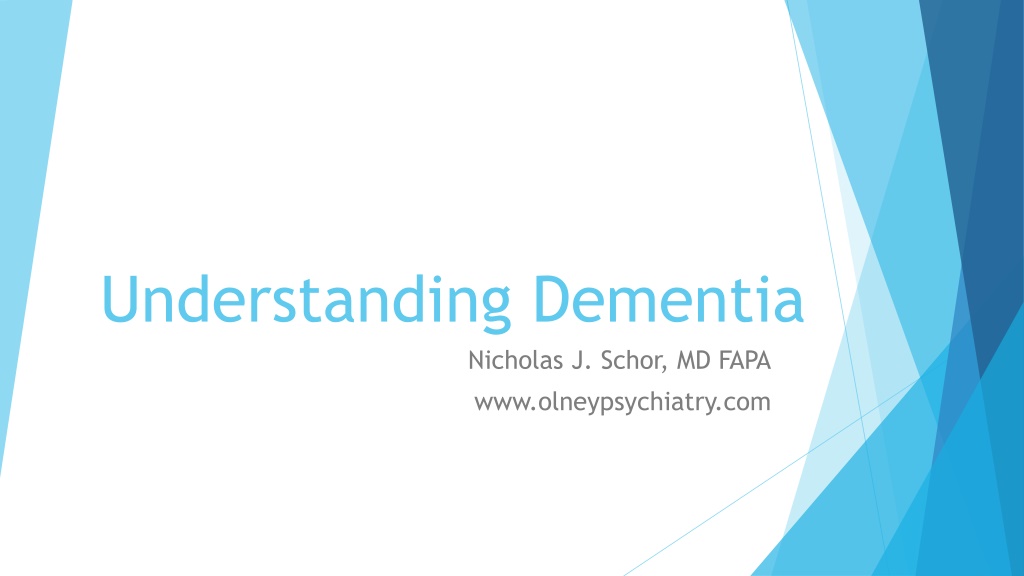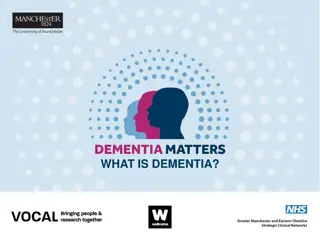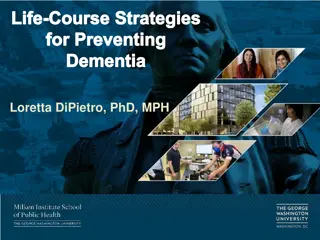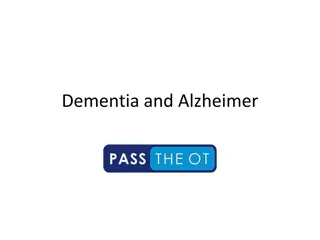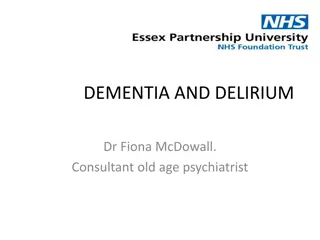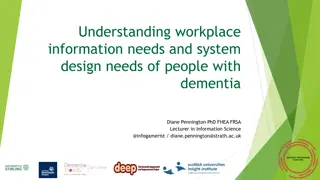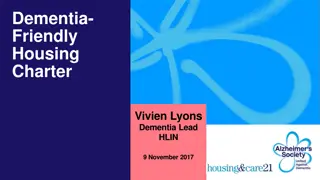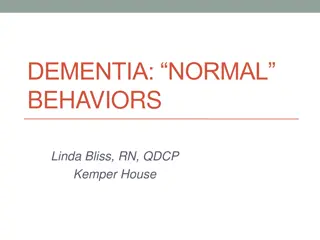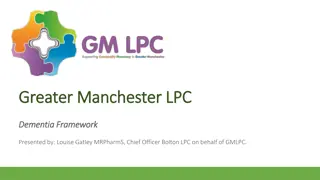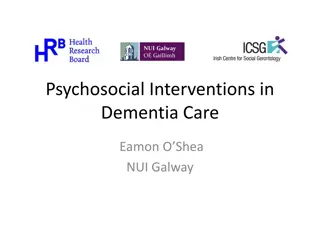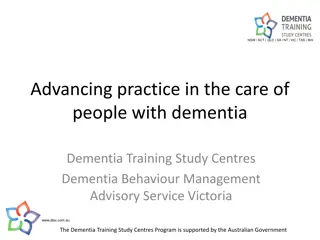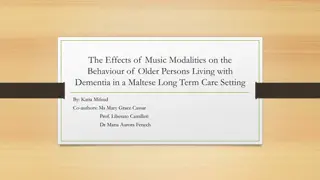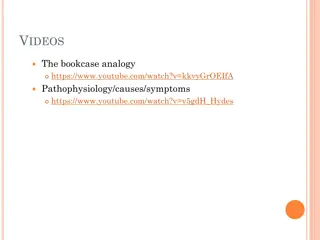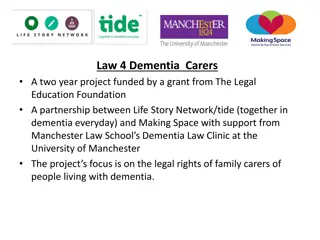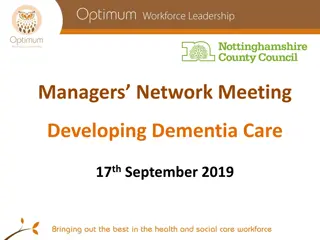Understanding Dementia: Core Definition, Types, and Treatments
Chronic disorder affecting mental processes due to brain disease or injury, leading to memory problems, personality changes, and impaired reasoning. Explores types of dementia, differentiation from other conditions, and treatment options as well as cognitive domains specified by DSM-5.
Download Presentation

Please find below an Image/Link to download the presentation.
The content on the website is provided AS IS for your information and personal use only. It may not be sold, licensed, or shared on other websites without obtaining consent from the author. Download presentation by click this link. If you encounter any issues during the download, it is possible that the publisher has removed the file from their server.
E N D
Presentation Transcript
Understanding Dementia Nicholas J. Schor, MD FAPA www.olneypsychiatry.com
Learning Objectives: Understand the core definition of Dementia Understand the various types of Dementia and what differentiates them from one another Understand the difference between Dementia and other conditions (Mild Cognitive Impairment, Delirium, Pseudodementia) Understand treatments and prognosis for Dementia
Dementiadefined A chronic or persistent disorder of the mental processes caused by brain disease or injury and marked by memory disorders, personality changes, and impaired reasoning which impairs one or more activities of daily living to the degree that it impacts safety and/or quality of life.
Generalizations about Dementia Dementias are primarily COGNITIVE disorders Acquired and represent decline (i.e. not developmental) Underlying brain pathology Major Neurocognitive Disorder: Significant Cognitive Decline, interferes with independence, not due to delirium, not due to other mental disorder Minor Neurocognitive Disorder (Mild Cognitive Impairment): moderate cognitive decline, does NOT interfere with independence, not due to delirium,not due to other mental disorder Minor: 1 2 standard deviation range on testing Major: more than 2 standard deviations on testing Do not determine based upon percentages on tests alone
Generalizations about Dementia Memory problems usually evident early Memory impairment alone is not enough to make the diagnosis
Cognitive domains specified DSM-5: DSM-IV: Complex attention Executive function Learning & memory Language Perceptual-motor Social cognition Memory impairment Aphasia Apraxia Agnosia Executive dysfunction
Dementia- defined Memory problems AND at least one additional cognitive deficit: Complex attention (maintain information in one s mind for a short time and to manipulate that information) Executive function (the mental processes that enable us to plan, focus attention, remember instructions, and juggle multiple tasks successfully) Learning & memory (short term Language (word finding difficulties Perceptual-motor(apraxia-impaired ability to use known objects, agnosia-trouble recognizing or identifying things despite intact sensations ) Social cognition (inappropriate behaviors, less social awareness) long term) aphasia)
Associated Features Spatial disorientation Poor insight and judgment means they get themselves in trouble by overestimating their abilities and underestimating risks Perceptual Abnormalities: Delusions- especially persecution Hallucinations- especially visual
More associated features Personality Changes: Disinhibition Neglect of personal hygiene Apathy and withdrawal Distillation/caricature
CLASSIFICATION BASED ON SITE ANTERIOR POSTERIOR SUB-CORTICAL CORTICAL # FRONTAL PREMOTOR CORTEX. # PARIETAL & TEMPORAL LOBE S. # APATHETIC # HIGHER CORTICAL ABNORMALTIES #BEHAVIOURAL CHANGES, LOSS OF INHIBITION, ANTI-SOCIAL BEHAVIOUR, FACILE & IRRESPONSIBLE # DISTURBANCE OF COGNITIVE FUNCTION (MEMORY & LANGUAGE) WITHOUT MARKED CHANGE IN BEHAVIOUR. #FORGETFUL AND SLOW POOR ABILITY TO USE KNOWLEDGE # DYSPHASIA, AGNOSIA, APRAXIA # ASSOCIATED WITH OTHER NEUROLOGICAL SIGNS & MOVEMENT DISORDERS. # Eg: NORMAL PRESSURE HYDROCPHALUS, HUNTINGTON S CHOREA, METABOLICAL DISEASE # Eg: ALZHEIMER S DISEASE # Eg: PARKINSON S DISEASE, AIDS DEMENTIA COMPLEX. # Eg: ALZHEIMER S DISEASE
CLASSIFICATION BASED ON CAUSE 1) ALZHEIMER S DISEASE (60% OF ALL CASES) 2) CEREBRO VASCULAR DISEASES (20% OF ALL CASES) MULTI INFARCT (ATHEROSCLEROTIC) DEMENTIA SUBCOURTICAL VASCULAR DISEASE BINSWANGER S DISEASE 3) NEURO DEGENERATIVE-PICKS DISEASE; HUNTINGTON S CHOREA; PARKINSON S DISEASE 4) INFECTIONS-CREUZFELD-JACKOB S DISEASE; HIV (AIDS DEMENTIA COMPLEX); VIRAL ENCEPHALITIS; PROGRESSIVE MULTIFOCAL LEUCOENCEPHALOPATHY 5) NORMAL PRESSURE HYDROCEPHALUS 5) NUTRITIONAL-WERNICKE KORSAKOFF (THIAMINE DEFICIENCY); B12 DEFICIENCY; FOLATE DEFICIENCY 5) METABOLIC-HEPATIC DISEASE; THYPOID DISEASE; PARATHYROID DISEASE; CUSHING S DISEASE 5) CHRONIC INFLAMMATORY-COLLAGEN VASCULAR DISEASE & VASCULITIS, MULTIPLE SCLEROSIS 5) TRAUMA-HEAD INJURY; PUNCH-DRUNK SYNDROME 5) TUMOR SOME-eg: SUBFRONTAL MENINGOMA CASES ARE TREATABLE; 10 DASH 15% ARE REVERSIBLE.
Alzheimers Named after Dr. Alois Alzheimer - a clinical psychiatrist and neuroanatomist First reported November 3, 1906
ALZHEIMERS DISEASE Most common type of dementia; accounts for an estimated 60 to 80 percentage of cases. Symptoms: Difficulty remembering names and recent events is often an early clinical symptom. Apathy and depression are also often early systoms. Later symptoms include impaired judgments, disorientation, confusing, behaviour changes and difficulty speaking, swallowing and walking. Brain changes: Hallmark abnormalties are deposits of the protein fragment beta-amyloid (plaques) and twisted strands of the protein tau (tangles) as well as evidence of nerve cell damage and death in the brain.
CEREBROVASCULAR DEMENTIA Previously known as multi-infarct or post-stroke dementia, vascular dementia is the second most commoncause of dementia after Alzheimer s disease. (20% of all cases) Eg: MUTLI-INFARCT DEMENTIA (ATHEROSCLEROTIC), SUBCORTICAL VD (BINSWANGER S DISEASE-SUBCORTICAL LEUCOENCEPHALOPATHY) Symptoms: Impaired judgement or ability to plan steps needed to complete a task is more likely to be the initial sysmptom, as opposed to the memory loss often associated with initial symptoms of Alheimer s. Occurs because of brain injuries such as microscopic bleeding and blood vessel blockage. The locationof the brain injury determines how the individual s thinking and physical functioning are affected Brain changes: Brain imaging can often detect blood vessel problems implicated in vascular dementia.
Binswangers Disease Progressive brain damage caused by arteriosclerosis and tiny clots in the blood vessels that supply the structures of the mid-brain (thalamus, basal ganglia). Formerly called hardening of the arteries Progressive memory loss, urinary incontinence Psychomotor slowness- slowed motor control/walking Apathetic, depressed, withdrawn, executive dysfunction, decreased spontaneity. Slowly progresses over 5-10 years
OTHER CAUSES DEMENTIA CAN OCCUR AS A SYMPTOM OF MORE WIDESPREAD DEGENERATIVE DISORDERS Eg: HUNTINGTON S DISEASE, DIFFUSE LEWY BODY DISEASE, PROGRESSIVE SUPRANUCLEAR PALSY, MOTOR NEURON DISEASE ETC. Symptoms: People with dementia with LEWY bodies often have memory loss and thinking problemscommon in Alzheimer s, but are more likely than people with Alzheimer s to have initial or early symptoms such as sleep disturbances, well-formed visual hallucinations, and muscle rigidity or other parkinsonian movement features. Brain changes: Lewy bodies are abnormal aggregations (or clumps) of the protein Alpha-synuclein. When they develop in the brain cortex, dementia can result. Alpha synuclein also aggregates in the brains of people with Parkinson s disease, but the aggregate may appear in a pattern that is different from dementia with Lewy bodies.
Lewy Body Dementia Similar issues as Alzheimer s PLUS: Motor Dysfunction/Parkinsonism(rigidity, tremor, shuffling gait, falls) Sensitivity to antipsychotic medications Autonomic dysfunction-impairment in regulation of temperature, BP, eliminatory functions, sexual dysfunction Hallucinations earlier in the disease REM Sleep Behavior Disorder (severe form of sleepwalking) Greater fluctuation between good/bad days-can relate to wide variation in attention
REM Sleep Behavior Disorder https://www.youtube.com/watch?v=rFXYRQ9xPUA
Treatment of Lewy Body Dementia Similar to treatment of Alzheimer s- cholinesterase inhibitors/memantine Avoidance of antipsychotics (when possible) +/- use of Parkinson s medications
HUNTINGTONS DISEASE Huntington s disease is a progressive brain disorder caused a single defective gene on chromosome 4. Symptoms: Include Huntington s chorea, dysarthria, dysphasia, facial twitching, chameleon or trombone tongue a severe decline in thinking and reasoning skills, and irritability, depression and other mood changes. Brain changes: The gene defect causes abnormalities in a brain protein that, overtime, lead to worsening symptoms. MIXED DEMENTIA In mixed dementia abnormalities link to more than one type of dementia occur simultaneously in the brain. Brain changes: Characterized by the hallmark abnormalities of more than one type of dementia most commonly, Alzheimer s and vascular dementia, but also other types, such as dementia with Lewy bodies.
NEURO GENERATIVE DEMENTIA: Eg: PICK S DISEASE, HUNTINGTON S CHOREA, PARKINSON S DISEASE Parkinson s disease As Parkinson s disease progresses, it often results in a progressive dementia similar to dementia with Lewy bodies or Alzheimer s. Symptoms: Problems with movement or a common symptom early in the disease. If dementia develops, symptoms are often similar to dementia with Louis bodies. RESTING TREMOR, AKINETIC RIGIDITY, BEN POSTURE, HYPOMIMIA Brain changes: Alpha-synuclein clumps are likely to begin in an area deep in the brain called the substantia nigra. These clumps I thought to cause degeneration of the nerve cells that produce dopamine.
DEMENTIA CAUSED BY INFECTIONS EG: CREUTZFELD-JACOB DISEASE, HIV INFECTION (AIDS-DEMENTIA COMPLEX), VIRAL ENCEPHALITIS, PROGRESSIVE MULTIFOCAL LEUCOENCEPHALOPATHY Creutzfeld-Jacob disease CJD is the most common human form of a group of rare, fatal brain disorders affecting people and certain other mammals. Variant CJD ( mad cow disease ) occurs in cattle, and has been transmitted to people under certain circumstances. Symptoms: Rapidly fatal disorder that impairs memory and coordination and causes behavior changes. Brain changes: Results from misfolded prion protein that causes a domino effect in which prion protein throughout the brain misfolds and thus malfunctions.
Kuru A transmissible spongiform encephalopathy (prion disease)that causes physiological and neurological effects which ultimately lead to death. It is characterized by progressive cerebellar ataxia, or loss of coordination/control over muscle movements, and uncontrollable laughter. Can incubate 5-13 years Seen in the Fore people of Papua New Guinea Caused by funerary cannibalism Last case seen 2005
Kuru Differential diagnosis: Creutzfeldt Jakob disease Causes: Transmission of infected prion proteins Symptoms: Body tremors, random outbursts of laughter Prevention: Avoid practices of cannibalism
HIV Infection (AIDS-Dementia complex) A condition that leads to the loss of intellectual abilities such as memory, judgment, and abstract thinking. It can also cause changes in personality. AIDS Dementia Complex (or ADC) is a type of dementia that occurs in advanced stages of AIDS (acquired immunodeficiency syndrome) These are some of the first signs and symptoms of ADC: Short attention span Trouble remembering Poor judgment Slow thinking and a longer time needed to do tasks Irritability Unsteady gait, tremor, or trouble staying balanced Poor hand coordination Social withdrawal or depression In later stages, you may have more server symptoms: Extreme mood swings Psychosis Loss of bladder and bowel control
Normal Pressure Hydrocephalus Symptoms: Symptoms include difficulty walking, memory loss and inability to control urination. Brain changes: Caused by the build up of fluid in the brain. Can sometimes be corrected with surgical installation of a shunt in the brain to drain excess fluid. Nutritional Eg: WERNICKE-KORSAKOFF (THIAMINE DEFICIENCY), B12 DEFICIENCY, FOLIC ACID DEFICIENCY WERNICKE-KORSAKOFF SYNDROME Korsakoff syndrome is a chronic memory disorder caused by severe deficiency of the thiamine (vitamin B-1). The most common causes alcohol misuse. Symptoms: Memory problems may be strikingly severe while other thinking and social skills seem relatively unaffected. Brain changes: Thiamine helps brain cells produce energy from sugar. When thiamine levels fall too low, brain cells cannot generate enough energy to function properly.
Magnetic Gait in NPH https://www.youtube.com/watch?v=vXtYuHqNVII
Wernicke-Korsakoff Syndrome Confusion Ataxia Opthalmoplegia Nystagmus Amnesia Confabulation Caused by demyelination of the mammillary bodies in the brain
By Metabolic disorders Eg: HEPATIC DISEASES, THYROID DISEASES, PARATHYROID DISEASE, CUSHING S SYNDROME Chronic inflammatory Eg: COLLAGEN VASCULAR DISEASE, VASCULITIS, MULTIPLE SCLEROSIS Trauma Eg: HEAD INJURY, PUNCH-DRUNK SYNDROME PUNCH-DRUNK SYNDROME A condition seen in boxers and alcoholics, caused by repeated cerebral concussions and characterized by weakness in the lower limbs, unsteadiness of gait, slowness of muscular movements, hand tremors, hesitancy of speech, and mental dullness. Boxers encephalopathy, dementia pugilistica. A syndrome affecting 10-20% of professional boxers, which is the cumulative result of recurrent brain damage and progressive communicating hydrocephalus and due to extrapyramidal and cerebellar lesions that translate into dysarthria, ataxia, tremors, pyramidal lesions causing mental deterioration and personality changes e.g., rage reaction and morbid jealousy Othello syndrome
Frontotemporal Dementia (Picks Disease) Pathologically / clinically heterogeneous disorder with focal degeneration of frontal and/or temporal lobes Onset typically late 50 s early 60 s; mean age 58 Earliest manifestations Personality changes / social behavior changes (behavioral variant) Language deficits Slowly progressive to more global dementia Some with motor symptoms 1/3 with family history
